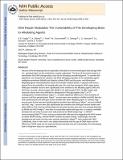| dc.contributor.author | Samson, Leona D. | |
| dc.contributor.author | Kisby, Glen E. | |
| dc.contributor.author | Olivas, A. | |
| dc.contributor.author | Park, T. | |
| dc.contributor.author | Churchwell, Mona | |
| dc.contributor.author | Doerge, Daniel R. | |
| dc.contributor.author | Gerson, S. L. | |
| dc.contributor.author | Turker, M. S. | |
| dc.date.accessioned | 2011-11-02T16:56:47Z | |
| dc.date.available | 2011-11-02T16:56:47Z | |
| dc.date.issued | 2009-01 | |
| dc.date.submitted | 2008-12 | |
| dc.identifier.issn | 1568-7864 | |
| dc.identifier.uri | http://hdl.handle.net/1721.1/66890 | |
| dc.description.abstract | Neurons of the developing brain are especially vulnerable to environmental agents that damage DNA (i.e., genotoxicants), but the mechanism is poorly understood. The focus of the present study is to demonstrate that DNA damage plays a key role in disrupting neurodevelopment. To examine this hypothesis, we compared the cytotoxic and DNA damaging properties of the methylating agents methylazoxymethanol (MAM) and dimethyl sulfate (DMS) and the mono- and bifunctional alkylating agents chloroethylamine (CEA) and nitrogen mustard (HN2), in granule cell neurons derived from the cerebellum of neonatal wild type mice and three transgenic DNA repair strains. Wild type cerebellar neurons were significantly more sensitive to the alkylating agents DMS and HN2 than neuronal cultures treated with MAM or the half-mustard CEA. Parallel studies with neuronal cultures from mice deficient in alkylguanine DNA glycosylase (Aag[superscript −/−]) or O6-methylguanine methyltransferase (Mgmt[superscript −/−]), revealed significant differences in the sensitivity of neurons to all four genotoxicants. Mgmt−/− neurons were more sensitive to MAM and HN2 than the other genotoxicants and wild type neurons treated with either alkylating agent. In contrast, Aag[superscript −/−] neurons were for the most part significantly less sensitive than wild type or Mgmt[superscript −/−] neurons to MAM and HN2. Aag[superscript −/−] neurons were also significantly less sensitive than wild type neurons treated with either DMS or CEA. Granule cell development and motor function were also more severely disturbed by MAM and HN2 in Mgmt[superscript −/−] mice than in comparably treated wild type mice. In contrast, cerebellar development and motor function were well preserved in MAM-treated Aag[superscript −/−] or MGMT-overexpressing (Mgmt[superscript Tg+]) mice, even as compared with wild type mice suggesting that AAG protein increases MAM toxicity, whereas MGMT protein decreases toxicity. Surprisingly, neuronal development and motor function were severely disturbed in Mgmt[superscript Tg+] mice treated with HN2. Collectively, these in vitro and in vivo studies demonstrate that the type of DNA lesion and the efficiency of DNA repair are two important factors that determine the vulnerability of the developing brain to long-term injury by a genotoxicant. | en_US |
| dc.description.sponsorship | United States. Army Medical Research and Materiel Command (Contract/Grant/Intergovernmental Project Order DAMD 17-98-1-8625) | en_US |
| dc.description.sponsorship | United States. National Institutes of Health (grants CA075576) | en_US |
| dc.description.sponsorship | United States. National Institutes of Health (RO1 C63193) | en_US |
| dc.description.sponsorship | United States. National Institutes of Health (P30 CA043703) | en_US |
| dc.language.iso | en_US | |
| dc.publisher | Elsevier Pub. Co. | en_US |
| dc.relation.isversionof | http://dx.doi.org/10.1016/j.dnarep.2008.12.002 | en_US |
| dc.rights | Creative Commons Attribution-Noncommercial-Share Alike 3.0 | en_US |
| dc.rights.uri | http://creativecommons.org/licenses/by-nc-sa/3.0/ | en_US |
| dc.source | PubMed Central | en_US |
| dc.title | DNA repair modulates the vulnerability of the developing brain to alkylating agents | en_US |
| dc.type | Article | en_US |
| dc.identifier.citation | Kisby, G.E. et al. “DNA repair modulates the vulnerability of the developing brain to alkylating agents.” DNA Repair 8 (2009): 400-412. Web. 2 Nov. 2011. © 2011 Elsevier Pub. Co. | en_US |
| dc.contributor.department | Massachusetts Institute of Technology. Center for Environmental Health Sciences | en_US |
| dc.contributor.approver | Samson, Leona D. | |
| dc.contributor.mitauthor | Samson, Leona D. | |
| dc.relation.journal | DNA Repair | en_US |
| dc.eprint.version | Author's final manuscript | en_US |
| dc.type.uri | http://purl.org/eprint/type/JournalArticle | en_US |
| eprint.status | http://purl.org/eprint/status/PeerReviewed | en_US |
| dspace.orderedauthors | Kisby, G.E.; Olivas, A.; Park, T.; Churchwell, M.; Doerge, D.; Samson, L.D.; Gerson, S.L.; Turker, M.S. | en |
| dc.identifier.orcid | https://orcid.org/0000-0002-7112-1454 | |
| mit.license | OPEN_ACCESS_POLICY | en_US |
| mit.metadata.status | Complete | |
